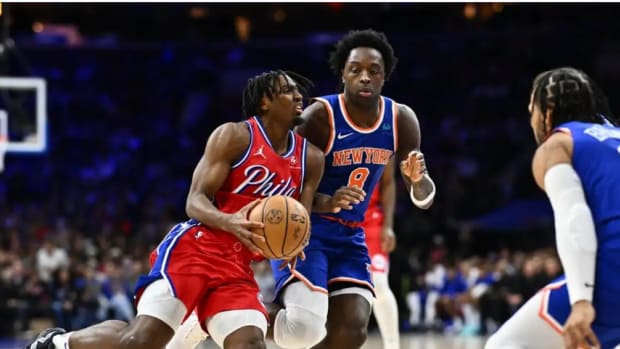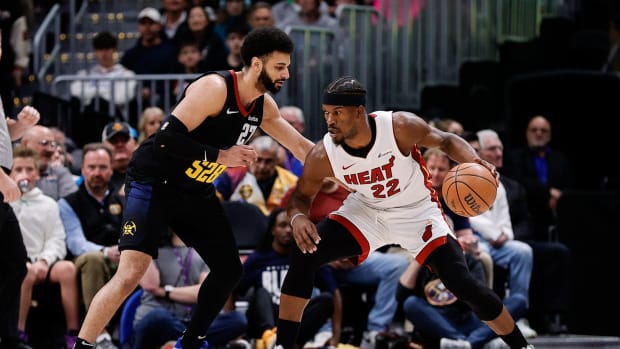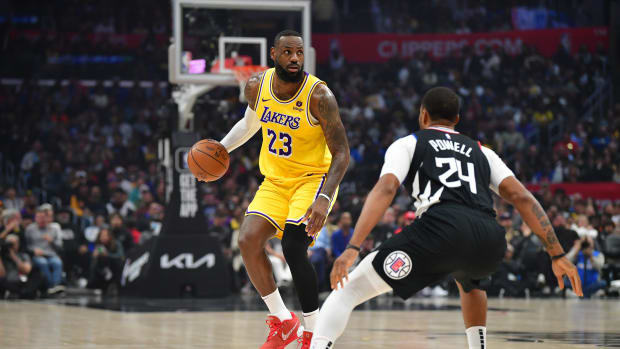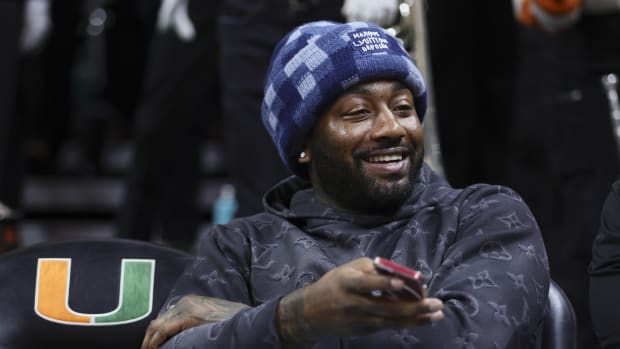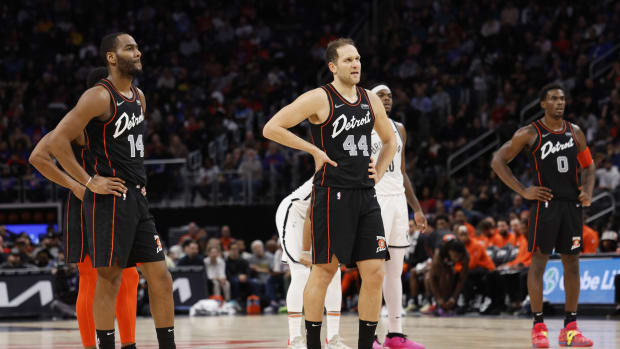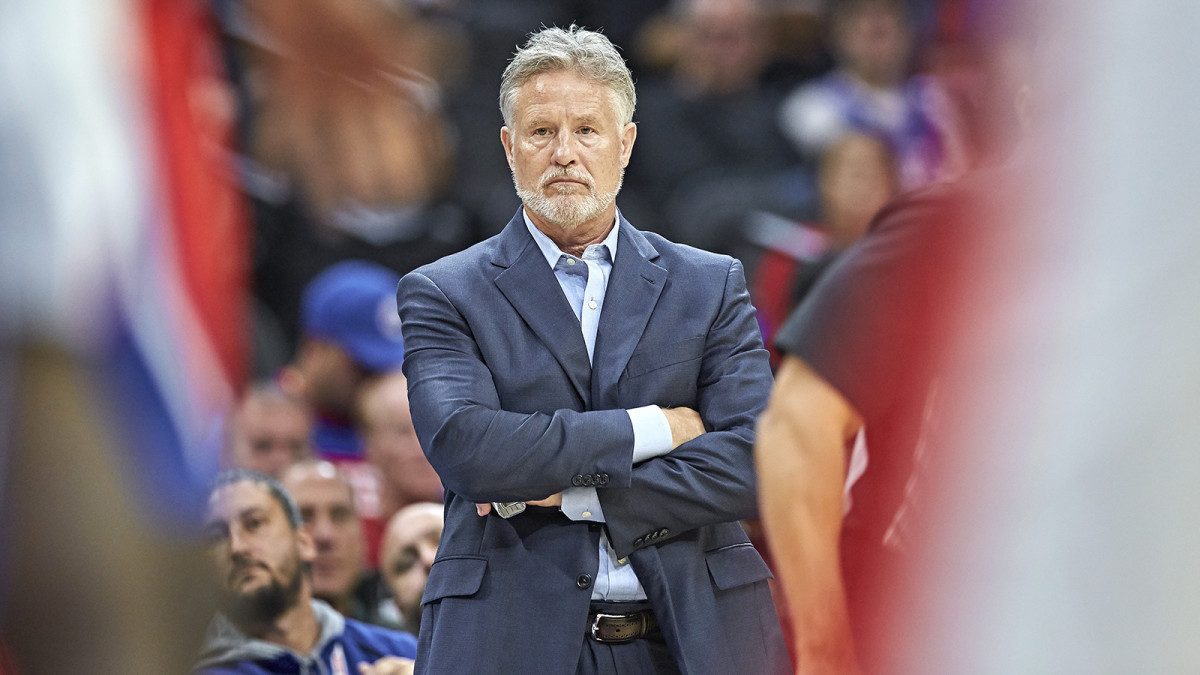
Brett Brown and the 76ers Are Thinking Big
Brett Brown is supposed to be on the second level of the Philadelphia 76ers’ practice facility for a 6 p.m. party, but it’s 6:35 and he very much is not. A crowd of tall men mills about, circling a table stocked with cheese and cured meats. Most of them once played basketball at St. Joseph’s and have come back to honor former Philadelphia assistant coach Billy Lange, who is about to start his first season as the school’s head coach. The Sixers and Brown offered to host the shindig at their shiny three-year-old complex, a physical monument to ownership’s complete overhaul of the franchise.
At 6:40, on the balcony overlooking the practice court, several name-tagged guys in suits sip beers as they watch someone on the hardwood below. It’s Brown, in a blazer, jeans and leather shoes, going over drills with two of his assistant coaches.
“Hey, Brett,” one of the balcony guys calls out.
“Hey,” Brown says, turning and looking up. He has a short white beard and whitish hair, but there’s a boyish quality to him. A few years ago, a picture of him playing Ping-Pong with particularly good form at a team outing went viral. The Internet thinks he’s a silver fox.
“How’s Dad?” the man asks.
“He’s great,” Brown replies, smiling. He loves talking about his father, Bob Brown, a legendary high school basketball coach in their home state of Maine. “Thank you for asking. I took him whitewater rafting this summer. The only 82-year-old to go on a class-5 rapid.”
The men are sufficiently impressed. Brown turns around to continue explaining the drill to his staff. He doesn’t make it up to the party for another 15 minutes, then keeps a low profile in the back of the room until it’s time to introduce Lange. Taking the podium, Brown comes alive. His eyes narrow and intensify as he looks around and smiles. He launches into a joke—he often launches into jokes—about a Canadian guy he coached with years ago.
“He told this story that’s kind of true for both of us,” Brown says, in his very particular accent, a confusing mix of Mainer and Australian that Spurs legend Tim Duncan describes as “Bos-tralian.”
“The coach comes home,” Brown continues, “and his wife says, after [he’s spent] many hours in the gym, ‘You love basketball more than you love me.’ He doesn’t blink. He says, ‘That might be true, but I love you more than I love hockey.’
“And he’s from Canada, so that’s pretty good!”
Brown has a lot of material to pull from when it comes to global sports jokes. He grew up playing for his father in high school and for Rick Pitino at Boston University before going on to coach in Australia for 17 years, serving as the head coach of NBL teams and the Australian national team. He’s been in the NBA since 2002, when he joined the Spurs, where he was head of player development and one of Gregg Popovich’s assistant coaches (and close friends). Brown is now entering his seventh season as coach of the Sixers, where he was hired by former general manager Sam Hinkie at the beginning of his unprecedented project in tanking: a multi-year process of bottoming out designed to collect draft picks and eventually build up a Larry O’Brien Trophy–caliber team.
Even if you don’t follow basketball, you know that “trust the Process” meant so much suffering that Philly fans started to wonder what exactly they were trusting. But over the last two years, the Sixers have become contenders. They have two gigantic All-Stars in Ben Simmons and Joel Embiid, and though they lost Jimmy Butler’s (mercurial) star power, they retained Tobias Harris and picked up dependable big man Al Horford, as well as 6' 6" guard Josh Richardson. They were a Kawhi Leonard miracle shot away from the 2019 conference finals and enter this season as a popular pick to win the East.
But as his team has heated up, so has Brown’s seat. A sizable group of Philly fans—or at least a vocal group, all with access to Twitter—wanted him fired after Brad Stevens outcoached him in the Sixers’ 2018 second-round loss to the Celtics. And The New York Times reported before last season’s Game 7 loss to Toronto that he was all but gone in the event of a Game 7 loss.
But Brown is still here, tasked with molding a roster that features a never-before-seen combination of size and talent. How he makes his giants fit together—or fails to—will determine not just the fate of the Sixers, but his own future.
Few coaches, if any, have survived a tanking process and gone on to win a championship. Brown has at least one more chance to try.
*****
Years before the first NBA lottery ball ever bounced, Brown’s grandfather was a hunting and fishing guide near the Canadian border in Maine. He also worked for the railroads, cleaning dead animals off the tracks so that trains headed to Quebec and Montreal could safely pass through towns so remote they have numbers instead of names. There’s peace up there. Brown still goes back to the Moosehead Lake region every summer, which is where he took his father whitewater rafting.
“We were coming down the river and we went down into the wave, and then boom, flipped up,” Bob says, laughing. “And I looked up, and there goes Brett. Fortunately I’m hanging on for dear life, and I didn’t go in the river.”
Brett refers to Bob (who also has a thick Maine accent, minus the Australian tinge) as the real coach of the family. It’s surprising to many, but there’s a vibrant basketball culture in Maine. Players who live in year-round island communities off the coast take hour-and-a-half-long ferry rides and then travel three hours by bus to play rival high schools. The winters are brutal. Friday nights in the gym make them more bearable.
“Some of the small teams like Beals Island had seven boys in the entire school in the ’50s,” says Bob, who’s a walking encyclopedia of Maine basketball. “And when they played for the state championship, I still remember that at least three of the seven boys in the school had the last name Beal.”
Bob was a high school coach near Augusta when Brett was born, and the family bounced from town to town for his jobs. When Brett was in middle school, Bob coached in Rockland, a fishing town on Penobscot Bay. The family regularly came home to buckets of lobster, halibut and clams sitting on their front porch, gifts from Bob’s players and their families. The Browns moved to Portland when Brett was in eighth grade, and in high school he played for his father. In Brett’s senior year, the team went undefeated and won the state championship by 44 points. Both Browns vividly remember the massive parade the town threw for them when they came home.
“I’ve had a chance to see the world from different vision lines, coaching overseas and in the NBA,” Brett says. “And the starting point was Maine. It’s one of those things in the light of day that still means something.”
Bob was an old-school coach, a disciplinarian, and Brett used to frustrate his father by sprinting home from his girlfriend’s house to be home by 10:59 for his 11 p.m. curfew. But the kid could play. Players Bob coached in high school say that he used to wheel out an old VHS player to show them tape of Brett in high school and in college. Brett has internalized his father’s sense of structure.
“I like routines,” he says. “There is a hint of rigidness in how I see the world. I think everybody wants to know the truth, and I think everybody down deep wants to be coached. The great ones certainly do. And you hope to have a level of accountability that reflects your beliefs. Coaching adults and fathers and multimillionaires is different from coaching the lobsterman’s son from Maine. That’s just the way it is. I’ve been raised in an environment where you know right and wrong.”
*****
Brown calls his office in the Sixers’ practice facility his “beachfront property”—the view isn’t as dramatic as back home, but he designed the room to look and open directly onto the practice court. His front wall is a window, with fancy shades that he can draw so that he can see out, but no one can see in. Brown helped architects shape the facility at the same time he was shaping the team. The team part was less straightforward, but Brown went in with his eyes open. He knew that executing Hinkie’s vision would be his class-5 rapid.
“I was at a stage where this was not going to define me,” Brown says. “I actually loved the challenge of the rebuild. I saw it clearly. And I love development. I’ve said before, you can coach under threat or you can coach for the challenge. The challenge was taking some very young teams and getting your teeth punched in on a nightly basis. The pain of losing is real. But I felt like it’s something I wanted to be a part of and help pull this off.”
Hinkie believed that Brown had the perfect experience for the job. He had been a head coach abroad for 17 years, was great at developing young talent and had spent 12 years at the side of a master in the NBA. His New England stoicism seemed well-suited to endure a rebuild as challenging, long and lonely as a Maine winter.
“Brett has an everyday optimism to consistently bring that kind of hope and energy to the staff and to the players,” Hinkie says. “I knew it was a big asset, but it turned out to be even bigger than I could’ve guessed. I thought he’d be great at it—he turned out to be legendary.”
Legendary may sound over-the-top, but Brown was good at persevering through loss after loss, including a season where the Sixers only won 10 games. “They couldn’t have had anybody better,” says Popovich. “I said a million times, after one year, maximum two, they’d have to put me in a strait-jacket, or fire me or get rid of me. No one could have stayed as positive as he stayed.”
Brown does have a fiery side—just watch him on the sideline during games—but through all the losing, he kept a meticulous and patient approach. Then and now, he reviews film individually with each player for 12 minutes each on an assigned schedule. He knows how to motivate. A few years ago, one player kept shooting from the wrong spot on the court during a drill. After about an hour of this, Brown blew the whistle. Everyone thought he was about to lose it, but instead, he walked over to the guy and held him by the waist.
“I’m going to help you, because when you stand here, you’re pretty good,” Brown said, then pulled the player four feet back. “But if you stand here, you’re a mother------. The NBA can’t f------ pay you enough. Stand right here, because when you stand there, no one can guard you.”
Brown does care deeply about his players—an important trait when your primary job is developing them. He famously missed a game against the Celtics in 2014 because he spent the night at Embiid’s apartment after the center found out his brother had been killed by a reckless driver in his home country of Cameroon. When rumors swirled of Brown’s firing last year, Embiid told reporters, “I got a lot of love for him,” and that if blame were to be assigned, blame Embiid himself.
T.J. McConnell—who played four seasons in Philly before signing with the Pacers last summer—remembers one game from his rookie year when the Sixers were losing to the Spurs by 50. McConnell wanted to get momentum going, especially since Popovich (below, with Brown in 2012) was on the other sideline. So he charged down the court and launched an airball. McConnell was visibly upset on the bench afterwards. Instead of getting angry, Brown sat down and put his arm around him. “This happens in the NBA,” McConnell remembers Brown saying. “You’re going to lay an egg.”
“It’s pretty much unheard of, when you hear of a coach staying with his job for three GMs,” McConnell says. It is, and Brown has—after Hinkie was fired, Bryan Colangelo came on board, but he resigned after his wife admitted to using Twitter burner accounts to leak team info. After Brown did a stint as interim GM, the Sixers hired Elton Brand, whom Brown coached in his third year in Philly.
“I think [his staying power] speaks volumes about who Brett is,” McConnell says. “He’s so knowledgeable in basketball, and at the same time he makes sure you’re good as a person, too.”
But being a good person only gets you so far. He aced step one of the Process, but to stick around, you need to win.
*****
Surviving a tank is rare. Surviving a tank and then winning is almost impossible, no matter the sport. The Astros went through managers Brad Mills and Bo Porter while tanking before hiring AJ Hinch, who won them a World Series. In the NBA, Dwane Casey endured 23- and 34-win rebuilding seasons in Toronto, worked five more years to turn the Raptors into a consistent contender . . . and then watched from home last June while his replacement, Nick Nurse, won the title. The conventional wisdom is that you need a patient coach to develop talent, but someone different to win. This could be Brown’s last shot to prove he can do both.
“The standard is that we want to win a championship,” Brown says. “So the rules have changed. Last year I had three iterations of a team. I couldn’t have gone into the locker room at the start of last year and looked at my team and said, ‘We’re here to win a title.’ None of us would’ve believed that was a fair goal. And now it is.”
But the Sixers were contenders last year. They traded for Harris and Butler. In the offseason, Butler opted to take his talents to South Beach rather than return to a team with a better shot of contending. All Brown will say about Butler, with whom he reportedly clashed, is that he remembers him for his random acts of kindness. But Brown won’t elaborate on what those were.
Even without the Butler wrench, how exactly the pieces of this team will fit together is unclear, because as talented as the roster is, it’s unlike any before it. Simmons is 6' 10". So is Horford. Embiid is 7 feet. Harris is 6' 9". Shooting guard Josh Richardson, acquired from the Heat in the Butler sign-and-trade, is oversized for a guard.
“I don’t know where the holes are or the mismatches,” Brown says. “We can play bully-ball offense and smashmouth defense, and it can easily be flipped, the same words apply: We’re big. Once you’ve recognized and admitted the design of team, you can dream. You can get creative.”
But there are still questions, and Brown will have to be creative to answer them. Will the Sixers run into issues when they face smaller, speedier teams? Can Embiid fix his late-game conditioning issues? Can Simmons develop a passable jump shot? When the 33-year-old Horford is alongside those two, will he able to guard smaller guys on the perimeter? Can someone replace JJ Redick’s ability to space the floor and shoot threes? Can Brown come up with the right lineups? Can this . . . work?
“I think what it depends on is if everybody fits together,” Popovich says. “The way the NBA changed, everybody assumes you have to shoot three-point shots all the time and that there’s no place for a big guy in the game anymore. But that’s really not true when you look at it really closely.”
It may all come down to Brown’s coaching. He’s proved that he knows how to teach, how to motivate, how to care for his players, how to crack the right joke at the right press conference. But can he win with what he’s built? If he can’t, he’ll probably lose his grip on the raft and get tossed into the river. “Everyone has an expiration date,” he concedes.
The Sixers’ season starts Oct. 23. Time to hold on tight.

































